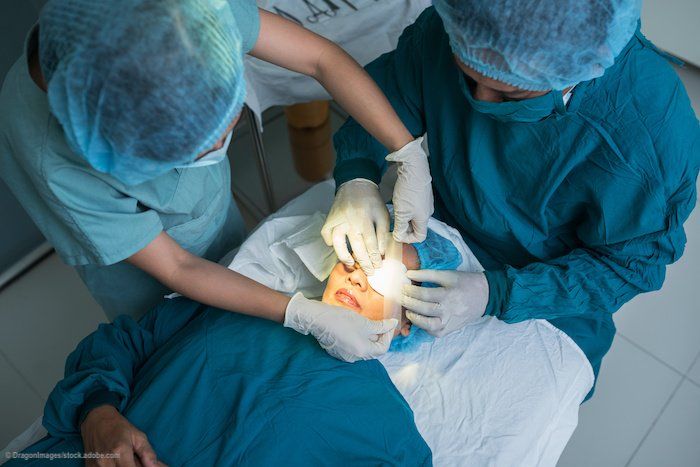Surgical update 2019: What every OD needs to know

Eye care is an ever-evolving field, and 2019 brought with it several advances in approach and technique that surgeons need to keep in mind as they adopt the latest best practices in glaucoma surgery.
Josh Johnston, OD, FAAO, in Atlanta Justin Schweitzer, OD, FAAO in Sioux Falls, SD, offered an overview of what surgical updates have come to optometry in the past year, speaking at Vision Expo West 2019 in Las Vegas.
New ways of looking at cataracts
A primary shift in thinking has been focused on cataract surgery. ODs are seeing a paradigm shift where patients expect their cataract procedures to produce positive refractive outcomes, even in cases of astigmatism and presbyopia.
“Modern cataract surgery can do that,” Dr. Johnston says.
A new era of intraocular implants (IOLs) is here, with toric, multifocal, and presbyopic IOLs on the market offering better results than older generations of implants.
Also on the horizon are extended depth-of-focus diffractive IOL designs that elongate focus.
“That spacing and height variation here gives you a range of vision,” Dr. Johnston says.
Future IOL technology
The world of IOLs is about to see even more exciting advancements.
Light-adjustable lenses offer a new approach to IOL placement. The method uses ultraviolet (UV) light to lock in IOLs after surgery. This offers predictable correction of residual refractive error after lens implantation for optimal distance vision, and the IOLs are customizable to control for monovision, near adds, and asphericity.
The advancements give more control to both ODs and patients.
The ability to adjust that implant in the first month speeds up the process,” Dr. Schweitzer says.
Another emerging technology is a refractive capsule with potential applications for IOL exchanges and drug-emitting devices.
ODs can also expect to see more applications for femtosecond laser-assisted cataract procedures.
“The femtosecond laser is more accurate for treating astigmatism,” Dr. Johnston says.
Other strategies such as dropless cataract surgery and laser fragmentation were also mentioned.
Related: Link between glaucoma and blood pressure
Endothelial keratoplasty (EK)
Descemet’s membrane endothelial keratoplasty (DMEK) is the latest iteration of EK. Compared to penetrating keratoplasty (PKP), EK offers faster recovery and less risk of rejection.
“Much speedier visual recovery, optically much better, fewer higher-order aberrations,” Dr. Johnston says.
A key advantage comes from how DMEK avoids stroma-to-stroma interface and offers the thinnest possible graft. DMEK also has lower graft rejection rates compared to more conventional options, such as PKP or Descemet’s stripping automated endothelial keratoplasty (DSAEK).
Related: Combining MIGS approaches paves way for future glaucoma surgeries
Minimally invasive glaucoma surgery (MIGS)
ODs can expect increased demand for MIGS management in their practices, says Dr. Johnston.
“It is the hot thing in surgical glaucoma right now. It is only going to continue to increase,” he says.
Since its infancy in 2012, many new options have launched to help patients manage their symptoms. Part of this demand is driven by poor patient adherence.
“More than 90 percent of patients are not adhering to their ocular dosing regimens,” he says.
MIGS can reduce the burden of medications, even if they don’t eliminate the need for them completely.
Options such as iStent inject (Glaukos), Hydrus Microstent (Ivantis), and tube shunts can offer minimally-invasive relief. Both iStent and Hydrus have been FDA-approved to be implanted in conjunction with cataract surgery.
The ideal patient type for these devices are those with both cataracts and mild to moderate glaucoma, Dr. Johnston says.
“It makes a lot of sense that one of those devices should be considered for your patients,” he says.
Corneal collagen cross-linking and refractive update
According to Dr. Johnston, the keratoconus mantra that ODs are familiar with has changed.
The treatment methodology used to involve diagnosis, application of special lenses, and an inevitable surgical procedure. Today, it is a process of early diagnosis, halting disease progression, and rehabilitating vision through lenses and tools.
There are also new strategies for topography-guided refractive correction, Dr. Johnston says.
“The goal with this is to be able to rehabilitate vision on people who, in the past, probably could not have had laser vision correction,” he says.
The objective of topography-guided correction is anterior surface normalization and vision rehabilitation. Topography-guided photorefractive keratectomy (PRK) offers benefits for normalizing the cornea, improving uncorrected vision, and improving image quality through glasses.
The small incision lenticule extraction (SMILE) procedure has been by the FDA with high rates of post-operative patient satisfaction. SMILE may offer comparable benefits to LASIK alongside possible improvements to dry eye.
Newsletter
Want more insights like this? Subscribe to Optometry Times and get clinical pearls and practice tips delivered straight to your inbox.